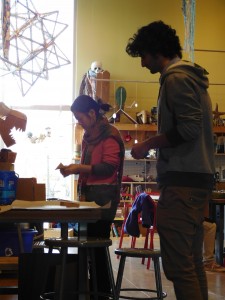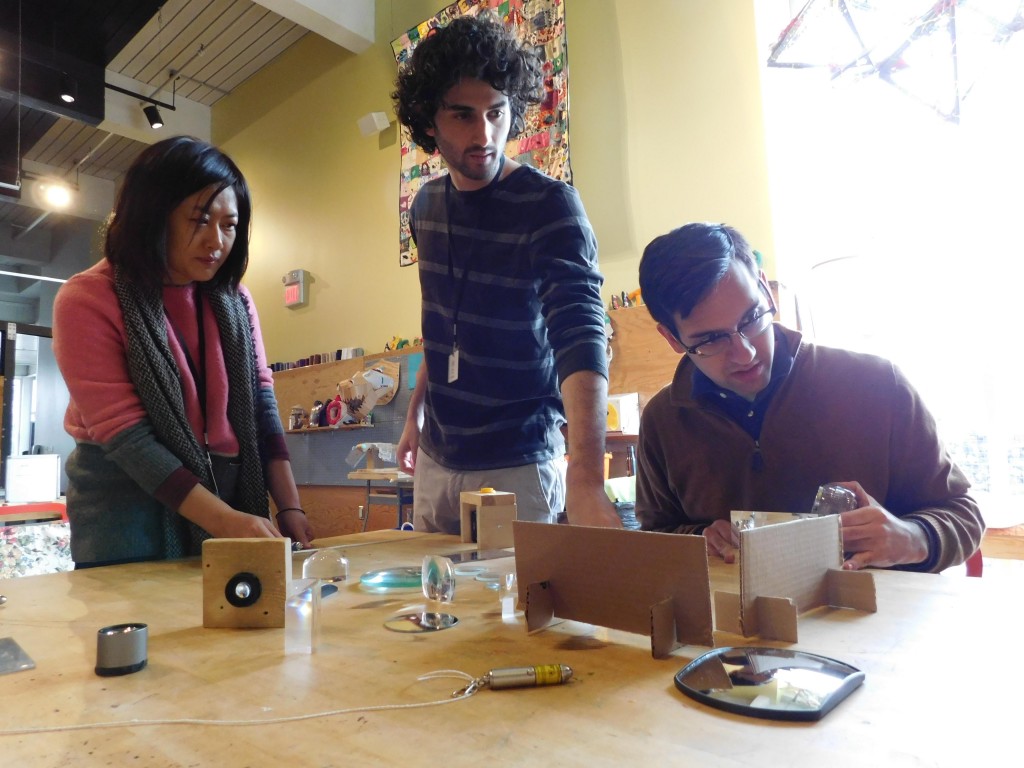As we approach halves (next week), and essentially our midterm presentation to the ETC faculty, Aristeia took some time to go over the playtests we have run to test our possible “design principles”. These principles were to be used to modify the activities being run at the MAKESHOP in order to facilitate family unit learning as oppose to just the child learning and the parents standing off to the side. Discussed below is what we have discovered.
Aristeia was exploring the hypothesis, “If a prompt is given that requires input from different family members, then the whole family will want to be involved in the project.” Additionally we wanted to see if such prompts helped to facilitate partakers into integrating stories (whether from pop media like Frozen or from their personal lives) into their design. We designed an activity in which the MAKESHOP guests would be given the prompt “What is a home?” and then would proceed to build their version of a house. Unfortunately, the playtest was not as successful as we had hoped.
The playtest failed because…
No one approached it. The activities facilitated by the Teaching Artists (TA’s) of the MAKESHOP were more prominently displayed and so all attention was diverted.
What we learned…
The next time we did a playtest of one of our design theories, test the theory in an activity that a TA is running.
The Second Playtest:
Aristeia waited a little while to playtest again. We needed to come up with a theory that would fit a TA’s activity for the day and preparing for that was tricky. Though the MAKESHOP had a schedule of activities posted on their website, the descriptions were too vague to glean anything from them; all we knew were the subjects being explored. Furthermore, we found through our bi-weekly, all-day visits to the MAKESHOP that the exact activities were often not decided until that very morning. In short, depending on when the TA’s decided on what projects to run, we had anywhere from 24 hours to 15 minutes to come up with a relatable playtest.
Eventually, we settled on the following hypothesis, “If an example provided for the activity was specific in what the end product would be but at the same time, appear to not look like it was made by a professional, then anxious parents who did not want to look inexperienced in front of others would feel more comfortable in partaking in the activity with their child.”
We had noticed that many anxious parents were potentially intimidated by the polished examples that the TA’s (who are trained artists themselves) provided and were afraid that they would be judged more so then their children for their skill level since they themselves were also adults.
Aristeia decided to test this theory with the Jango Blocks, which were different geometric shaped blocks that helped to explore how joints worked. We chose this because it was a popular activity that people easily approached and did many different things with. We set up crudely drawn pictures of what could be built and waited to see what happened. This playtest proved to be more sucessfull.
The playtest succeeded because…
Adults were more willing to play with the blocks and experiment with what could be built. They used the pictures as a basis but a lot ended up building something completely different. We also found that they tended to use the pictures that mostly resembled the shapes displayed by the blocks as a starting point.
Aristeia was excited by this. We finally had a successful playtest. We play tested the theory again under more controlled circumstances: fixing the examples so that guests wouldn’t hoard them and making them more resemble the Jango Blocks. Again we experienced more success and felt that we were ready to hand this theory off to the TA’s to see what would happen if they implemented it themselves.
That was when we found out our playtest was only a partial success. The TA’s pointed out that by choosing the Jango Blocks as our testing activity, we were changing the activity from exploring how joints connected and focusing it on building a product, which was not what they wanted to happen at all. They were also concerned about the possibility of “dumbing down” their own examples. Many kids took their projects home so most examples displayed were made by them. After conversing with each other more, Aristeia concluded that our theory would not work in an environment such as the MAKESHOP which was a continuously evolving and changing environment where things moved and activity plans changed half-way throughout the day. In the end, we classified this playtest as a bust.
This playtest we ran simultaneously with the second playtest and on the MAKESHOP activity titled the “Laser Blocks”, in which MAKESHOP guests could play with lasers, point them through different lenses and prisms, and try to hit two fixed bullseye points which would activate a pop-up flag and a twirling figure.
We felt that this activity would be perfect to playtest the following hypothesis, “If an answer was provided for a goal in which many different answers would suffice, then guests who were not open to exploring would be more inclined to do so.” We set up the laser blocks where a barrier would block the bullseyes and provided one answer as to how to bend the laser lights to hit them.
The playtest failed because…
The task proved to be too difficult for many people to solve on the time that they had to spend at the museum.
Because the lasers were handheld and not fixed, people just moved the lasers instead. When we inquired about fixing the lasers, we were met with negativity from the TAs because it didn’t match the original intention they had for the activity.
After going through our successes and failures, we came up with three important conclusions.
- The MAKESHOP environment was too unstable to set up an activity to playtest a principle as the environment and activity setup were constantly being changed and modified by the TAs based on their observations.
- To playtest and come up with a set of verified design principles that are proven to work on the MAKESHOP audience would take too long for the time that we had left. Maybe if we had a year instead of roughly a month left…
- The TAs are given a lot of freedom to experiment themselves in the MAKESHOP space and coming up with completely set design principles would be of no use to them, especially in the environment they work in. If we provide them anything, it would have to be completely open to adaption or it would be quickly phased out.
Due to these conclusions, Aristeia decided to stop using our observations and research to come up with set design practices for the TA’s to use to facilitate family learning in the MAKESHOP.
Instead, we talked to our client and together decided to use our observations and research to come up with a set of design tools for the TA’s to identify what possible problems they could encounter in facilitating family learning, and to help come up with the design principles themselves. In short: same assets that we came up with, but set to a different purpose.
- Written by Aly Soto


